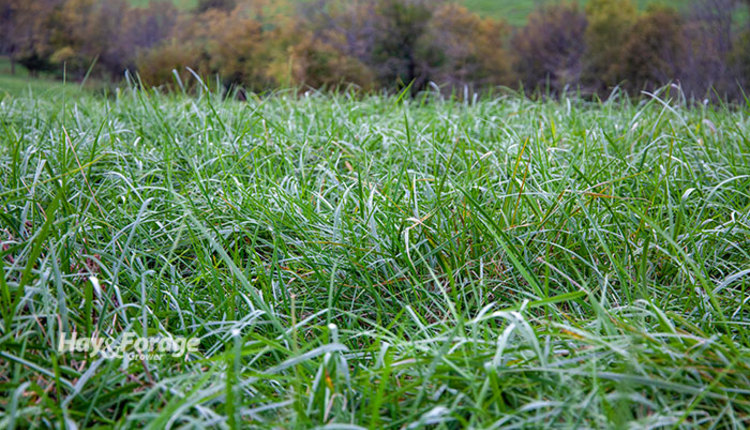
Alan Franzluebbers has been on a mission to better quantify the need for nitrogen in pasture systems. “If you have no nitrogen, then you have no yield,” said the USDA-ARS research scientist, “But it’s become fairly clear that not all pastures are low in available nitrogen, so that’s not just something we can assume.”
Nitrogen is critical for grass production. At the same time, in a plant-available form, nitrogen is a mobile nutrient in the soil and is subject to leaching. “We have to reckon with the fact that nitrogen is an important component of environmental pollution,” said the soil scientist based in Raleigh, N.C., while speaking at the American Forage and Grassland Council’s Annual Meeting in Winston-Salem, N.C., earlier this month.
“If we are to make or modify new recommendations for practices such as fertilizer applications, it’s important for research experiments to encompass a diverse set of conditions,” Franzluebbers asserted.
Nitrogen is found in inorganic and organic forms in soil. The inorganic form can be measured as nitrate or ammonium in the soil, but Franzluebbers told his audience that we need to better understand the organic part and the factors important for the conversion of organic nitrogen to inorganic nitrogen, a process known as mineralization.
“There are pastures that are low in plant available nitrogen where adding nitrogen fertilizer results in a tremendous yield response,” Franzluebbers said. “However, we’ve also found pasture sites where adding nitrogen fertilizer did not boost yield. We need to find out why and when this is occurring, because if we keep applying nitrogen in these situations, it only contributes to a negative environmental impact and is a waste of the farmer’s money.”
Soil biology holds the answer
Franzluebbers said the key for farmers is to grow the biologically active pool of carbon and nitrogen. “This carbon comes from plants, which are digested by animals, then redeposited in the form of manure,” he explained.
Can we predict the amount of organic nitrogen mineralized in soil?
Yes, in the lab, under ideal conditions, Franzluebbers noted that differences in soil are easy to differentiate. There is a linear relationship between soil biological activity and nitrogen availability. But these lab measures are not entirely useful in a field situation in which weather can vary substantially from year to year and farm to farm.
Franzluebbers used 92 test sites across multiple states to measure soil biological activity and forage response to nitrogen applications. Detailed weather data were also collected to assess when temperature and moisture were impacting nitrogen mineralization.
The soil scientist noted that the price of fertilizer should be considered when making recommendations because the amount of economic yield response will vary with nitrogen price. At the recent high point of nitrogen fertilizer prices, about 10 additional pounds of forage was needed to pay for the cost of 1 pound of nitrogen.
Nitrogen response varied
Franzluebbers presented data from several of his case study farms. At one, measured soil biological activity indicated about 41 pounds per acre of mineralized nitrogen would be available in the top 4 inches of soil during the fall fescue stockpile period. As expected, forage yield response occurred when additional nitrogen fertilizer was applied at different rates. The optimum economic nitrogen rate at this site was 69 pounds of nitrogen per acre. This would be in line with most university nitrogen recommendations for fall-stockpiled forage.
At another farm, which was a 30-year-old stockpiled tall fescue pasture being rotationally grazed, 85 pounds of available nitrogen from mineralization was estimated based on biological activity. In this case, about 40 pounds of additional nitrogen proved to be the optimum economic nitrogen rate.
In a third 10-year-old fescue pasture, Franzluebbers found the economic optimum nitrogen rate to be zero. This field had a predicted nitrogen mineralization capacity of nearly 120 pounds per acre. A fourth 30-year-old project field provided similar results.
“Nitrogen fertilizer almost always resulted in a forage quality benefit,” Franzluebbers said. “But the forage quality benefit and slight yield improvement may not cover the cost of fertilizer in these pastures with high biological activity and nitrogen mineralization rates.”
Grass systems tend to lead to higher biological activity than annual cropping systems. And that’s even more true with perennial grasses, Franzluebbers explained. Stand age also makes a difference.
In suggesting that a change be made for pasture nitrogen recommendations, the USDA scientist has been met with resistance from some farmers and university researchers. That hasn’t stopped Franzluebbers from developing his own recommendation scheme based on lab-measured soil biological activity, which actually analyzes for CO2 release after a soil is dried and then rewetted. This measure has been found to be associated with nitrogen mineralization capacity.
In summarizing, Franzluebbers noted that pastures are ecological systems that evolve over time. “A new pasture without fertilizer is probably not going to produce very much,” he said. “In contrast, an older pasture that has developed biological activity over time will provide some level of mineralized nitrogen unless you’re in an arid region. We need to use the tools we have available to make better management decisions for our farms and the environment.”

